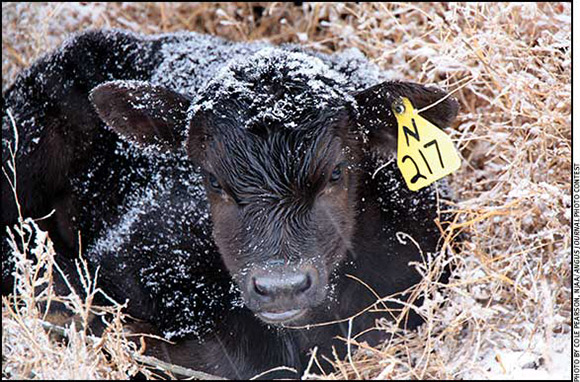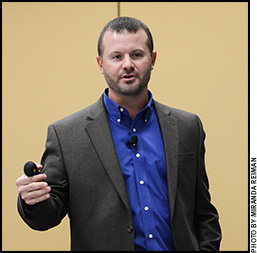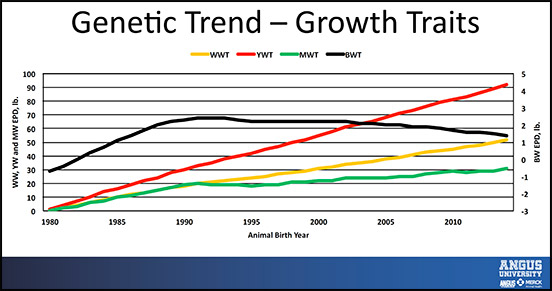
Smaller Isn’t Always Better
Dan Shike discusses calf size, gestation optimums in Angus University Workshop.
There is no “one size fits all” in the cattle business. So it is with calving ease and birth weight, too, said Dan Shike, University of Illinois animal scientist. He presented on finding the optimums during an Angus University Workshop sponsored by Merck Animal Health Nov. 6 at the 2016 Angus Convention in Indianapolis, Ind.
Cow size, calf size and shape, and presentation all figure into calving season success.
“We could approach and address calving-ease problems by making our cows bigger,” he said. “There’s probably not a lot of people interested in that as a primary approach.”
That’s why, historically, there’s been such a major spotlight on birth weight.

“Focus on calving ease, not birth weight. Don’t keep driving birth weight down,” the University of Illinois’ Dan Shike told Angus University participants.
In the Angus breed, expected progeny differences (EPDs) for weaning and yearling weight have undergone a steady increase since the 1980s, but birth weight peaked in the mid-1990s and has gone down since (see graph).
“Both genetics and environment can have an impact,” Shike said, noting factors like weather and nutrition.
To gauge what breeders think is ideal, the animal scientist polled those in the room. About half of the attendees answered a series of questions via text message.
“What birth weight do you consider excessive for cows?” Shike asked.
In real-time results, the majority (56%) selected greater than 90 pounds (lb.), another 33% said greater than 100 pounds (lb.) and 6% said more than 110 lb.
Only 6% selected “greater than 80 lb.,” until the question changed to the perspective of “your commercial customers.” Then 29% of the crowd said greater than 80 lb. was too big, indicating some selection pressure is based on customer preference. At 53%, the majority still said greater than 90 lb.
“What is optimum? Can we make it too small?” Shike asked.
 The range was from less than 40 lb. to less than 70 lb., with about half of respondents saying either less than 50 lb. or less than 40 lb. is “too light.”
The range was from less than 40 lb. to less than 70 lb., with about half of respondents saying either less than 50 lb. or less than 40 lb. is “too light.”
The fear with short gestations and very small calves is not only that the animals won’t catch up on the growth curve, but also that their initial start won’t be ideal, Shike said.
“They’re not going to get up; they’re not going to nurse. They’re not going to get their colostrum, which makes them susceptible to those early health challenges,” he said. “That’s going to stay with them through their whole life, and it’s going to have an impact on their performance. That’s the concern, and that’s why we’re talking about it.”
Shike shared Illinois data on two different groups of fall-born steer calves sorted into thirds for low, average and high birth weight.
The Charolais-Angus-cross steers didn’t show a difference in number of treatments required, but death loss prior to weaning was 15% for the light one-third and just below 2% for the heavy one-third.
“I don’t know if everyone realizes what portion of those that don’t make it are in the bottom third,” he said of its impact on the farm or ranch.
On the data from Angus steers, there was a linear decrease in preweaning death loss, 14.4% to 8.6%, as birth weights increased. Numerically, carcass quality improved with larger calves, but it was not statistically significant.
“What about gestation length? Is that a contributing factor?” Shike asked.
Using artificial insemination (AI) records, he sorted those same Charolais-Angus calves on gestation length, into groups of less than 276 days, 277 to 280 days, and greater than 281 days.
That classification also showed that as gestation length increased, death loss prior to weaning decreased, from 12.1% in the shortest-gestation group to 7.5% for those over 281 days.
Although there was an increase in hot carcass weight, the amount of time a calf spent in utero didn’t appear to impact carcass quality in this study.
“I still think it probably could … in an extreme case,” Shike said, noting the fall-calving advantage during a nice September in southern Illinois. “Most people would argue the short gestation and lighter birth would be much more problematic where it was cold. Even though this short gestation might have made them more susceptible, they weren’t really challenged.”
The take-home for breeders is simple, Shike said: “Focus on calving ease, not birth weight. Don’t keep driving birth weight down.”
Also, be self-aware.
“I’m not sure we all need to target the same calving ease,” he said, noting many herds have generations stacked with calving ease maternal. If environmental factors are favorable and there aren’t calving problems, “You probably don’t need those double-digit calving-ease bulls.”
Shike’s presentation was one of the Angus University Workshops sponsored by Merck Animal Health Nov. 6 at the 2016 Angus Convention. For additional coverage of the Angus Convention, tune in to The Angus Report on RFD-TV the week of Nov. 21 and watch for coverage in the Angus Journal and the Angus Beef Bulletin. Summaries, speaker presentations, photos, videos and much more can be found online at www.angus.media.







